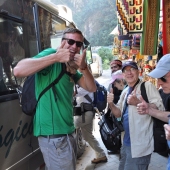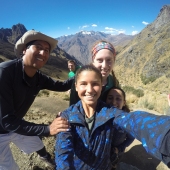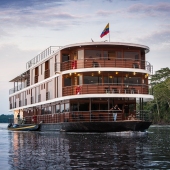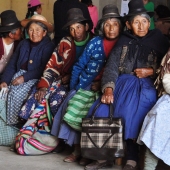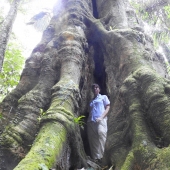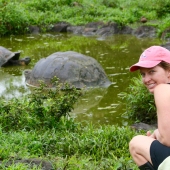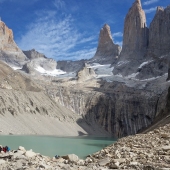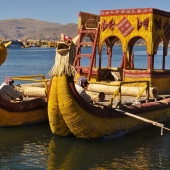
Do Native Peruvians Wear Costumes for the Tourists?
One of the first things that travelers to the high altitude city of Cusco, Peru may notice, is the colorful clothing worn by many citizens of the Andes. The first stop on the way to Machu Picchu, is the city of Cusco, which offers an exotic visual contrast between Qechua descendents clothed in the bright colorful handmade clothing of their Inca ancestors, side by side with contemporary Peruvians draped in the latest factory-made fashionable outfits.. Are the local people dressing up in costumes for tourists? Is this their everyday attire?
Native indigenous Peruvians come from small communities where they wear brighly colored clothing and hats of various designs that indicate the region or community they come from. Most of these garments are hand woven from wool collected from sheep and alpaca farm animals.
Qechua women stroll the cobbled streets of their ancestors decked out in unique and colorful skirts, jackets and headwear. it's likely you will be approached by one or more of them with their young children and sometimes a llama, offering to pose for photos. This is how they earn their living. One side trip to the small communities in the nearby Sacred Valley provides insight into this custom. Is it real or fake?
Men may be adorned in multi-colored ponchos and knitted hats with ear flaps, known as "chullos." Natrve Peruvian women can be seen attired in knee length swing skirts layered with "underskirts" that create a bouncing affect when they walk.
Do native Peruvians wear garments made with vicuna wool?
The ultra-soft vicuna wool can only be collected on a limited basis from wild animals roaming the highlands. Vicuna is one of the softest naturally occuring yarns I have ever touched. One of the reasons for the high cost of garments made from vicuna wool, is that the animals cannot be domesticated. They live free or die. The wool is collected from the animals in limited amounts and woven into amazing sweaters, scarves, hats and ponchos. One interesting thing about the wool is that it cannot be dyed. The garments come in limited colors including "vicuna" brown, black and off white. Be aware that some resellers may tell you a garment is vicuna wool, but it may be a blend. You may see a native man wearing a poncho made from vicuna. These pieces are special and families pass them down like heirlooms.
Why are Peruvian native Qechua people dressed in colorful clothing?
If you look at the lifestyle of the indigenous Qechua people, living in the countryside in small communities and farms, you'll understand why they choose this kind of colorful attire. The raw materials are readily available from the farm animals like sheep, llama and alpaca. The women are masterful weavers who begin to learn how to dye, prepare yarns, use back-strap looms and design stunning textiles. as soon as they are old enough to handle the materials. Girls start out by braiding fibers into long decorative ropes that are attached to the edges of textiles to finish the piece. Girls learn how to identify and collect plants, roots, leaves and even cochineal bugs on cactus used to create the various colors.
When you "live off the land" as the Qechua natives do, you use the resources you have at hand to create the things you need in your everyday life. You may specialize in certain cottage industries. For example, making pottery or garments, growing fava bean or potatoes, raising guinea pigs, sheep or alpaca, or making adobe bricks for homes. At the heart of each community is the trade of your service or product for someone elses.
Earning money to buy factory made prodcuts is limited. Men need picks and axes and tools for farming, not to mention nails and roofing materials for their adobe homes.. The cooks and porters you see on the multi-day treks and Inca Trail hikes come from these villages. They earn a small amount of cash which is how they acquire some of these modern world products. While having some cash is necessary, their skills and talents are the most essential to this kind of lifestyle.
One of the most noteworthy characteristics of wool is it's durability and warmth, even in wet environments. Homes in the countryside are not heated and wearing wool is a sensible way to protect yourself from the various elements when you're outside all day. Except for women who prepare meals in their kitchens, life in a Qechua village is spent outdoors much of the day. And it goes without saying that beds are shrouded in handmade woolen blankets for cozy comfort at night.
I"m happy to report that indigenous Qechua people adorned in their native garb are authentic. They're the real deal. If you want to support them, buy their hand-made textiles and pay them for posing for a photo in Cusco. One of the best places to meet Qechua people is around the outside of San Pedro market in Cusco. Look for people adorned in unique hats and clothing. And if you're heading through the Sacred Valley, be sure to stop at the village of Chinchero where Qechua women have formed weaving co-ops to demonstrate how they prepare wool right off the back of a sheep to the beautiful finished textiles which are for sale.
Do the Qechua native people ever "dress up?"
As a matter of fact, yes they do. Every year at the Inti-Raymi (Sun god) festival in June, you can see qechua children of all ages from the surrounding mountains, assemble in their best native costumes to perform native dances. This is one example of how the Qechua people keep the Inca influence alive. Other smaller parades where people dress up, occur throughout the year. You may be walking through the streets of Ollantaytambo on a Wednesday, when all of a sudden you hear live horns and drums followed by an enthusiastic group of performers adorned in Inca-inspired clothing, "dancing in the street."
If you have time to explore, drop me a line and I'm happy to provide more info about how we can arrange excursions to places that are off the beaten path.


